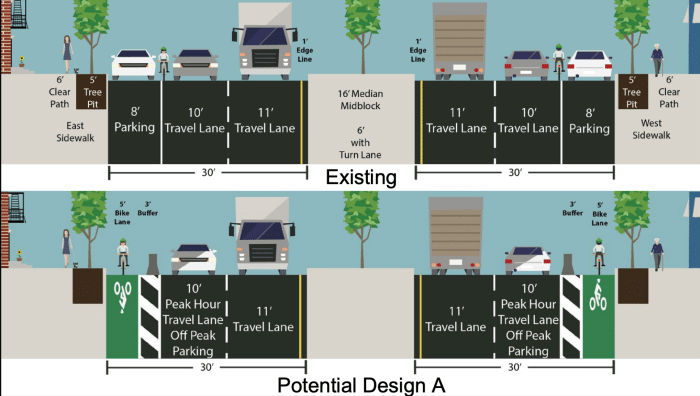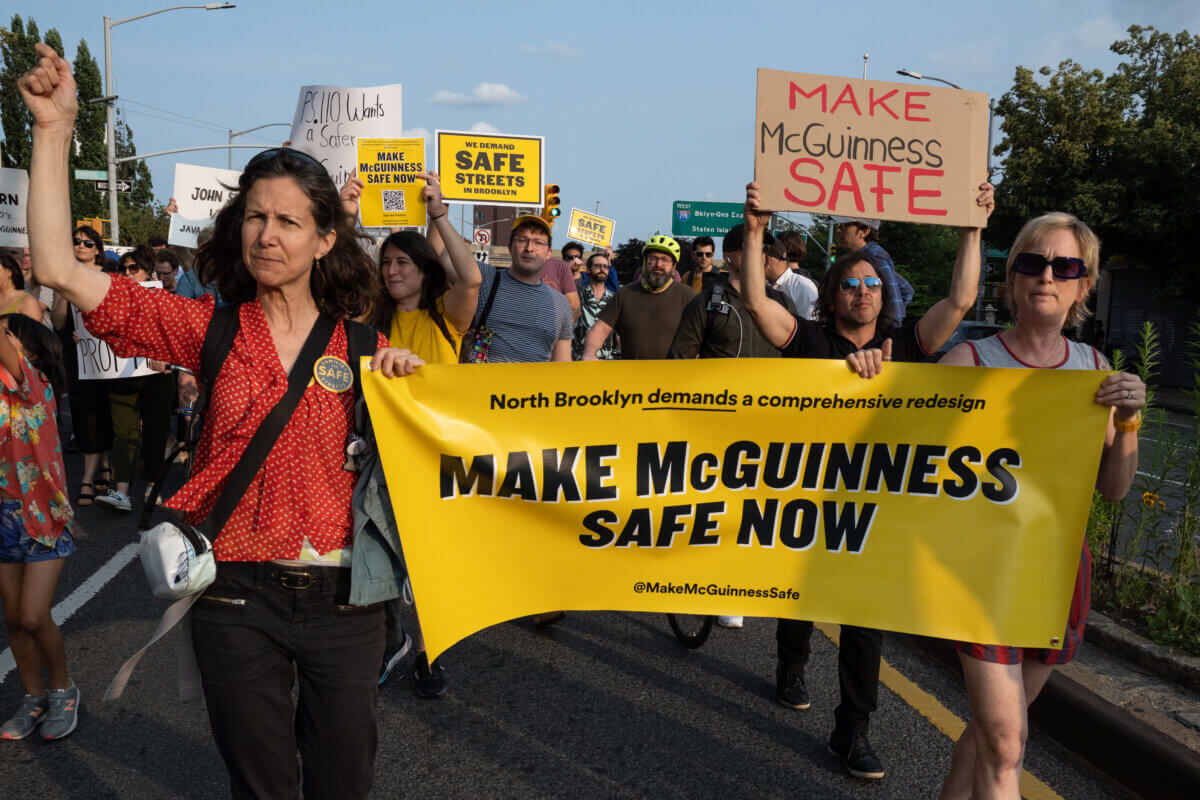McGuinness compromise: cars stay, bikes come
Activists and politicians said the redesign would not make the dangerous street safer for pedestrians and cyclists.
By Kirstyn Brendlen, Brooklyn Paper
Nearly a year after the city backed away from its plan to remodel McGuinness Boulevard, it announced its plans for the southern half of the busy thoroughfare on Tuesday – a departure from its original proposals last summer.
Instead of removing a lane between Calyer Street and Meeker Avenue, as was proposed last year, the Department of Transportation will keep the design already in the works for the northern half of the street: protected bike lanes along each curb, with two lanes open during rush hours. Between 7 p.m. and 7 a.m., the right lane will become a parking lane to slow car traffic on the fast-moving street.
The Department of Transportation will also renovate the Brooklyn-Queens Expressway ramp at Meeker Avenue, add a new pedestrian connection between Bayard Street and Meeker Avenue, and install “traditional” bike lanes on five streets around McGuinness.

Work is expected to begin in September.
The announcement sparked outrage among local road safety groups and politicians who have been pushing for years for a drastic transformation of this notoriously dangerous road.
“Greenpoint residents have demanded that Mayor Adams finally address the deadly conditions on McGuinness Boulevard and make our community safer, but he has ignored us,” nine local elected officials, including U.S. Rep. Nydia Velázquez and Council Member Lincoln Restler, said in a joint statement. “After repeatedly changing his mind and undermining the Department of Transportation’s evidence-based redesign, Mayor Adams is continuing a plan that will fail Greenpoint by maintaining the most dangerous elements of this roadway that runs through the middle of our community. We will not stop fighting until we successfully put the safety of our neighbors above all else.”
Last summer, after Mayor Eric Adams ordered the agency to reconsider its original plan to rehabilitate McGuinness Boulevard, the Department of Transportation presented a “compromise” with two different proposals for the northern and southern sections of the road. The northern section between the Pulaski Bridge and Calyer Street would receive protected bike lanes and retain two lanes for vehicles during rush hour, with overnight parking.
On the southern half of McGuinness, between Calyer Street and Meeker Avenue, the department planned to eliminate a lane in favor of parking and a protected bike lane. Work would begin on the northern half first, the department said at the time, with the southern half soon to follow.
However, the Department of Transport did not complete work on the northern half until late 2023, and then announced it would need to complete a traffic analysis for the southern part of the street before it could finalize its plan there. As of May 2024, work north of Calyer Street had not been completed, nor had the analysis.

U.S. Department of Transportation officials did not immediately say whether the analysis had been completed before announcing the scaled-back plan on August 20.
“This redesign of McGuinness Boulevard will make this corridor much safer for everyone, including motorists, pedestrians and cyclists,” said DOT spokesperson Vin Barone. “Based on community feedback, NYC DOT will extend the protected bike lane from Calyer Street to Meeker Avenue while also constructing a new network of bike lanes that better connect cyclists to Meeker Avenue and further south, and adding sidewalk extensions to streets that intersect McGuinness Boulevard.”
When asked for comment, a representative from Adams’ office referred Brooklyn Paper to the Department of Transportation.
The wide four-lane road, which locals say is prone to speeders and dangerous drivers, saw 229 accidents involving injuries between 2015 and 2019, according to a 2023 DOT presentation. Most pedestrian injuries occurred when victims were struck by truck drivers while the pedestrian was crossing the street despite a traffic light.
Since then, around 88 crashes have been reported along the road, according to CrashMapper, including that of 58-year-old cyclist Liem Nhan, who was killed by a delivery truck driver in 2019, and PS 110 teacher Matthew Jensen in 2021. Jensen’s deaths galvanized the community and inspired the creation of the road safety group Make McGuinness Safe. It also inspired then-Mayor Bill de Blasio to donate $39 million to redesign the road.
The “final” plan, announced last spring and quickly scrapped, would have created a two-way lane along the entire length of McGuinness Boulevard. At the time, the Department of Transportation said it was the plan that had the most support of the three options the agency had proposed.
But opponents, led by Broadway Stages, criticized the plan, claiming it would negatively impact local businesses. Their votes, and those of mayoral adviser Ingrid Lewis-Martin, were reportedly what prompted Adams to reverse course last year.
Some said even the compromised plan would harm the community.
“The community is deeply concerned about the impact of diverted traffic on our residential streets, delayed emergency response times, and many other issues affecting residents and businesses – not only in Greenpoint, but in neighboring areas such as Williamsburg, Bushwick, Long Island City, Maspeth, etc.,” Keep McGuinness Moving said in August 2023. “We will continue to promote our ideas and ideals that are more productive and safe.”
Following the August 20 announcement, Make McGuinness Safe said the Department of Transport had “broken its promise” to the Greenpointers.
“We have asked the city to protect our community – pedestrians and cyclists, children and seniors – from future trauma after decades of suffering the consequences of an unnecessary freeway dividing our neighborhood,” the group said. “Instead, we are losing parking, giving up loading zones and getting an unsafe, unprotected bike lane next to a freeway.”
Editor’s note: A version of this story originally appeared in the Brooklyn Paper. Click here to see the original story.
You might also like
Email [email protected] with any additional comments, questions or tips. Follow Brownstoner on X and Instagram, and like us on Facebook.

